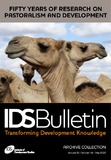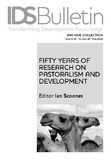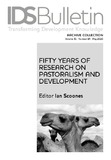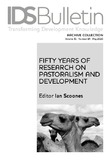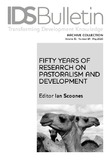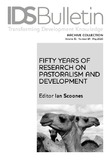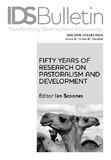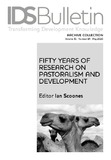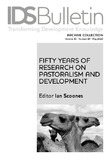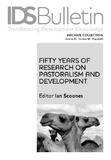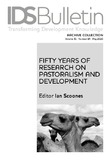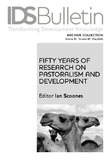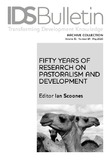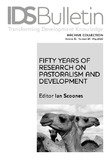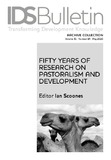Volume 51. Issue 1A: Pastoralism and Development: Fifty Years of Dynamic Change
Browse by
Recent Submissions
-
Pastoralism and Development: Fifty Years of Dynamic Change
(Institute of Development Studies, 2020-05-26)This archive IDS Bulletin reflects on 50 years of research on pastoralism at IDS. Much has changed, but there are also important continuities. The ‘end of pastoralism’ was proclaimed widely in the 1970s, yet, as a successful, ... -
Notes on Contributors: Fifty Years of Research on Pastoralism and Development
(Institute of Development Studies, 2020-05-26)This is the note on contributors for IDS Bulletin 51A 'Pastoralism and Development: Fifty Years of Dynamic Change'. -
Pastoralism and Development: Fifty Years of Dynamic Change
(Institute of Development Studies, 2020-05-26)This archive IDS Bulletin reflects on 50 years of research on pastoralism at IDS. Thirteen articles are introduced around six themes that have characterised IDS-linked research over this period. These are: pastoral ... -
Access to Food, Dry Season Strategies and Household Size amongst the Bambara of Central Mali
(Institute of Development Studies, 1986-07-31)The Bambara village of Kala lies on the northern frontier for regular crop production in Mali (see Map). With a long term mean rainfall of 600 mm per year, this region forms part of the southern Sahelian zone. Rainfall is ... -
Gender and Livelihoods in Northern Pakistan
(Institute of Development Studies, 1995-01-31)This article reports on research done in 1993-94 in the Hunza and Nagar districts in the Karakorum mountains in the Northern Areas of Pakistan. It was designed to explore whether increasing demands on women's labour inputs ... -
Local Customary Institutions as the Basis for Natural Resource Management Among Boran Pastoralists in Northern Kenya
(Institute of Development Studies, 1991-10-31)This paper argues, ors the basis of a specific case of a pastoral economy in northern Kenya, that customary natural resource management rules and institutions may provide a better starting point for development policies ... -
Institutional Change in the Syrian Rangelands
(Institute of Development Studies, 2001-10-31)Bedouin pastoral communities in West Asia and North Africa have developed different mechanism for coping with rainfall variability and seasonal feed resources (Masri 1991; Metral 2000; Nesheiwat 1991). Amongst these ... -
Climate Change and the Challenge of Non-equilibrium Thinking
(Institute of Development Studies, 2004-07-31)Climate change is happening, that much is certain. But in what way? How much? And with what impacts? Complex, non-linear models try to predict trends and patterns, but, inevitably, each model is different, parameters are ... -
Pastoralists, Patch Ecology and Perestroika: Understanding Potentials for Change in Mongolia
(Institute of Development Studies, 1991-10-31)An alternative view of pastoral livelihood systems has begun to emerge in recent years that places much greater stress on the need to understand ecosystem dynamics. It draws particularly on empirical work in African drylands ... -
Why are Rural People Vulnerable to Famine?
(Institute of Development Studies, 1989-05-31)It is now generally accepted by researchers (although not by governments) that famines are caused as much by act of man as by act of god. But our understanding of famine is still quite rudimentary, and what little we know ... -
Food Security: Let them Eat Information
(Institute of Development Studies, 1994-05-31)Insufficient information to predict famine was widely seen to be a central reason for the failure of national governments and the international donor community to prevent famines in Africa in the mid 1980s. Since then, ... -
Communities, Commodities and Crazy Ideas: Changing Livestock Policies in Africa
(Institute of Development Studies, 2005-06-30)In the late 1990s a review of aid-assisted livestock projects included an assessment of sustained impact on poorer producers (Ashley et al. 1998). The review looked back over 35 years and analysed documents from more than ... -
Youth Participation in Smallholder Livestock Production and Marketing
(Institute of Development Studies, 2017-05-31)Agriculture is a leading source of employment for rural populations in Kenya. Through a mixed methods approach, this study sought to investigate youth participation in smallholder livestock production and marketing in ... -
Reconstructing Political Order Among the Somalis: The Historical Record in the South and Centre
(Institute of Development Studies, 2013-01-31)The reconstruction of a larger polity in a violence-torn society such as Somalia requires negotiation of a new social contract between the superordinate body and the local units of governance that have provided citizens ... -
Livestock Raiding Among the Pastoral Turkana of Kenya: Redistribution, Predation and the Links to Famine
(Institute of Development Studies, 1996-07-31)It is now recognized that violence plays a decisive role in the breakdown of coping strategies leading to famine in Africa today This is especially the case where armed conflict magnifies trends already discernible as a ... -
Conflict Management for Multiple Resource Users in Pastoralist and Agro-Pastoralist Contexts
(Institute of Development Studies, 1996-07-31)Livelihood systems in rural social formations often involve the utilization of natural resources for multiple purposes (e.g. wetlands which are used for both cropping and for grazing) or by more than one user (as when ...

